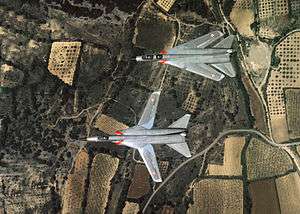Dassault Mirage G
The Dassault Mirage G was a French two-seat twinjet variable-geometry prototype fighter, built by Dassault Aviation in the late 1960s. The type was further developed into the twin-engine Mirage G4 and G8 variants as a multi-role jet fighter capable of both interception and nuclear strike missions. Although Dassault built and flew prototypes, the entire programme was terminated in the 1970s without the aircraft entering production.[1]
| Mirage G | |
|---|---|
 | |
| The Dassault Mirage G8-01 and G-8-02 prototypes in flight. The G8-01's wings are swept. | |
| Role | Swing-wing multirole fighter |
| Manufacturer | Dassault Aviation |
| First flight | 18 November 1967 |
| Status | Cancelled in the 1970s |
| Primary user | French Air Force |
| Number built | 3 |
| Developed from | Dassault Mirage F2 |
Development
In 1964 the French defence ministry requested a development programme on variable-sweep wing aircraft for dual land and aircraft carrier use. France had participated with the Anglo-French Variable Geometry aircraft (AFVG) before abandoning their interest; later Dassault received an order for a prototype, powered by a single Pratt & Whitney/SNECMA TF-306 turbofan in October 1965.[2]
The first variable-sweep aircraft from Dassault emerged as the single-engined, two-seat Mirage G fighter in 1967, essentially a swing wing version of the Mirage F2. The wings were swept at 22 degrees when fully forward and 70 degrees when fully aft and featured full-span double-slotted trailing edge flaps and two-position leading edge flaps.[3]
Flight trials were relatively successful but no production order ensued, the Mirage G programme being cancelled in 1968.[2] Flying with the Mirage G continued however until 13 January 1971 when the sole prototype was lost in an accident.
Variants
Mirage G
Single-engined initial version, first flight 18 November 1967. Crashed 13 January 1971.
Mirage G4
The basic Mirage G was developed into a twin-engine, two-seat nuclear strike fighter, the Mirage G4 after a separate contract was issued in 1968 for two aircraft to be built. These aircraft were intended to be powered by Snecma M53 turbofans in production.[2] While the aircraft were under construction the requirements changed and the French military requested that the design be converted into a dedicated interceptor, the Mirage G8.[2]
Mirage G8
Mirage G4-01 was redesignated G8-01 and remained a two-seat aircraft (first flight 8 May 1971) with the second aircraft, G4-02 becoming a single-seat version, G8-02 (first flight 13 July 1972).[2] The G8 variants were equipped with Thomson-CSF radar and a low-altitude navigational-attack system based on that used in the SEPECAT Jaguar and Dassault Milan.[1][2] As no funding was included for the Mirage G8 in the 1971-1976 French defence budget the aircraft did not enter production.[1]
Cooperation on LTV V-507
The Ling-Temco-Vought company was in search of skills on the variable-geometry wings, within the framework of the program Light Weight Fighter (future McDonnell Douglas F/A-18 Hornet) and in search of the VFX (future Grumman F-14 Tomcat).[4] This company decided to cooperate with the Avions company Marcel Dassault, which had just made a success of the development of the Mirage G. Two agreements were signed in 1968, for general cooperation and other one on the variable-geometry wings. For the competition VFX, the prototype LTV V-507,[5] inspired by the Mirage G, was rejected to the benefit of the Grumman F-14 Tomcat. In the reading of the file of the LTV V-507, the Grumman company asked for numerous further information, in front of the interest of the technical solutions held for the Mirage G. The Pentagon envisaged this plane as basis for the program Light Weight Fighter, but other solutions were used.
Aircraft on display
- Dassault Mirage G8-01 is on public display at the Musée de l’air et de l’espace near Paris.[6]
- Dassault Mirage G8-02 is on public display at the Musée Européen de l'Aviation de Chasse, Montélimar.[7]
Specifications (Mirage G8-02)
General characteristics
- Crew: 1
- Length: 18.8 m (61 ft 8 in)
- Wingspan: 15.4 m (50 ft 6 in)
- Lower wingspan: 8.7 m (28 ft 7 in) swept
- Height: 5.35 m (17 ft 7 in)
- Empty weight: 14,740 kg (32,496 lb)
- Powerplant: 2 × SNECMA Atar 9K50 after-burning turbojet engines, 49.03 kN (11,020 lbf) thrust each dry, 70.1 kN (15,800 lbf) with afterburner
Performance
- Maximum speed: Mach 2.2
- Range: 3,850 km (2,390 mi, 2,080 nmi)
- Service ceiling: 18,500 m (60,700 ft)
See also
Related development
Aircraft of comparable role, configuration and era
Related lists
References
Notes
- Green 1972, p. 84.
- Dassault Aviation - Mirage G history www.dassault-aviation.com Retrieved: 10 April 2010
- Green 1968, p. 78.
- Claude Carlier, Une formule aérodynamique gagnante. La grande aventure des « Mirage » à géométrie variable, 2, Le Fana de l’aviation, n° 537, august 2014
- The Vought V-507. Posted on July 2, 2014 by Ian D'Costa - ; Blast from the past....Ling-Temco-Vought (LVT) V-507 ; Vought designs the 1960s-1970s "Archived copy". Archived from the original on 2016-09-03. Retrieved 2016-08-28.CS1 maint: archived copy as title (link)
- Musée de l'Air et de l'Espace - Collections (French language) Archived 2016-03-04 at the Wayback Machine www.mae.org Retrieved: 13 April 2010
- Mirage G8-02 - Musée europeen de l'aviation de chasse (French language) www.meacmtl.com Retrieved: 7 November 2017
Bibliography
- Green, William. The Observer's Book of Aircraft. London. Frederick Warne & Co. Ltd., 1968.
- Green, William. The Observer's Book of Aircraft. London. Frederick Warne & Co. Ltd., 1972. ISBN 0-7232-1507-3
External links
| Wikimedia Commons has media related to Dassault Mirage G. |